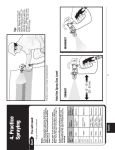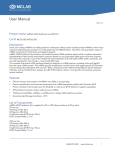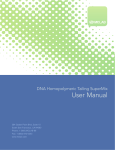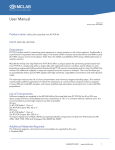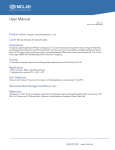Download User Manual
Transcript
Molecular Cloning Laboratories User Manual Version 1.0 Revision Date: 08/23/2013 Product name: RNA Poly(A) Tailing Kit Cat #: RPTK-100, RPTK-200 Description: The RNA Poly(A) Tailing Kit provides high pure and active enzyme and other reagents for quickly and easily adding a poly(A) tail to the 3´ end of any RNA. MCLAB newly engineered Poly(A) Polymerase uses ATP as a substrate for template-independent addition of adenosine monophosphate to the 3´-hydroxyl termini of RNA molecules. Cloned Poly(A) Polymerase is encoded by an E. coli gene and overexpressed in the host strain. Applications: - Addition of a poly(A) tail to an RNA molecule or a mixture of RNA molecules in order to provide a priming site for synthesis of first-strand cDNA using a primer with poly(dT) on its 3´ end. - Addition of a poly(A) tail to RNA synthesized in vitro in order to increase the stability of the RNA and enhance its ability to be translated in vivo after transfection or microinjection into eukaryotic cells. - Synthesis of polyadenylated RNA for nucleic acid amplification methods or gene expression studies. - 3´-end labeling of RNA or quantitate mRNA. Recommended Storage Conditions: -20°C List of Components: RNA Poly(A) Tailing Kit is supplied for 20 or 100 tailing reactions of 20 µL each. RNA Poly(A) Tailing Kit 20-rxn size: Tailing Enzyme Mix 20 µL 10X Reaction Buffer 200 µL 10 mM ATP Solution 40 µL RNA Poly(A) Tailing Kit 100-rxn size: Tailing Enzyme 100 µL 10X Reaction Buffer 200 µL 10 mM ATP Solution 200 µL Protocol: The following protocol is designed as a general guideline for generating a poly(A)-tail length of ~100 bases. Customizing reaction to reach desired tailing length could be reached by adjusting such as enzyme concentra- 1-(650) 872-0245 www.mclab.com 1 tion and/or incubation time. 1. Set up reaction in a PCR tube on ice as below: Component Quantity * Note 10x Reaction Buffer 2 μL 1x Nuclease-free water To 20 μL 10mM ATP 2 μL Tailing Enzyme Mix 1 μL RNA Template x μL 1mM 1-10µg *: For multiple reactions, master mix should be made with 5% extra reagents to reduce pipette error. 2. Gently mix thoroughly and then centrifuge briefly. 3. Incubate the tube at 37°C for 20 minutes 4. Stop reaction by appropriate methods according downstream applications, such as –20°C storage, EDTA addition or through common purification process. References: 1. Drummond, D.R. et al. (1985) J. Cell. Biol. 100, 1148. 2. Galili, G. et al. (1988) J. Biol. Chem. 263, 5764. 3. Lingner, J. and Keller, W. (1993) Nucleic Acids Res. 21, 2917. 2


